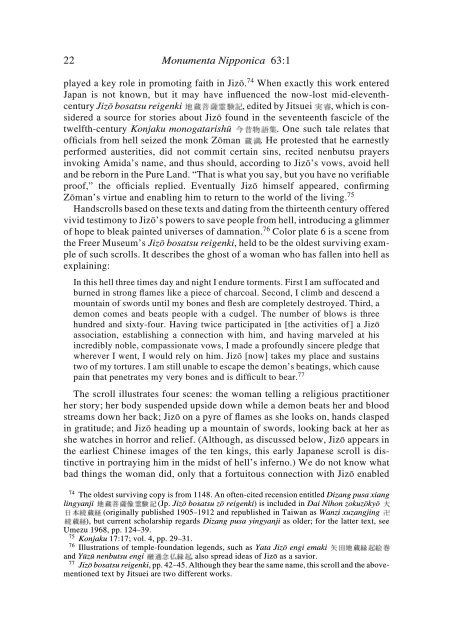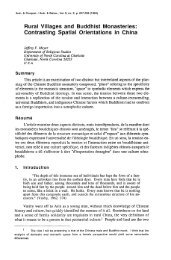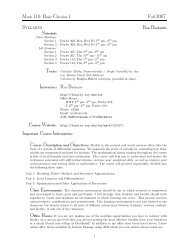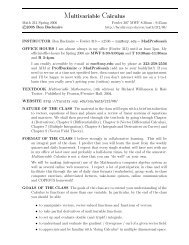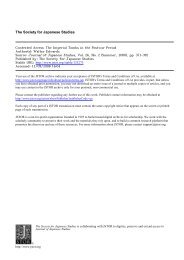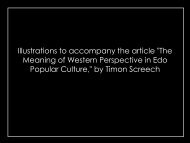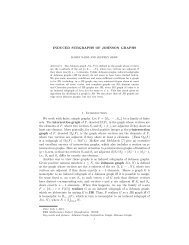A Primer on Japanese Hell Imagery and Imagination - Occidental ...
A Primer on Japanese Hell Imagery and Imagination - Occidental ...
A Primer on Japanese Hell Imagery and Imagination - Occidental ...
You also want an ePaper? Increase the reach of your titles
YUMPU automatically turns print PDFs into web optimized ePapers that Google loves.
22<br />
M<strong>on</strong>umenta Nipp<strong>on</strong>ica 63:1<br />
played a key role in promoting faith in Jizô. 74 When exactly this work entered<br />
Japan is not known, but it may have influenced the now-lost mid-eleventhcentury<br />
Jizô bosatsu reigenki , edited by Jitsuei , which is c<strong>on</strong>sidered<br />
a source for stories about Jizô found in the seventeenth fascicle of the<br />
twelfth-century K<strong>on</strong>jaku m<strong>on</strong>ogatarishû . One such tale relates that<br />
officials from hell seized the m<strong>on</strong>k Zôman . He protested that he earnestly<br />
performed austerities, did not commit certain sins, recited nenbutsu prayers<br />
invoking Amida’s name, <strong>and</strong> thus should, according to Jizô’s vows, avoid hell<br />
<strong>and</strong> be reborn in the Pure L<strong>and</strong>. “That is what you say, but you have no verifiable<br />
proof,” the officials replied. Eventually Jizô himself appeared, c<strong>on</strong>firming<br />
Zôman’s virtue <strong>and</strong> enabling him to return to the world of the living. 75<br />
H<strong>and</strong>scrolls based <strong>on</strong> these texts <strong>and</strong> dating from the thirteenth century offered<br />
vivid testim<strong>on</strong>y to Jizô’s powers to save people from hell, introducing a glimmer<br />
of hope to bleak painted universes of damnati<strong>on</strong>. 76 Color plate 6 is a scene from<br />
the Freer Museum’s Jizô bosatsu reigenki, held to be the oldest surviving example<br />
of such scrolls. It describes the ghost of a woman who has fallen into hell as<br />
explaining:<br />
In this hell three times day <strong>and</strong> night I endure torments. First I am suffocated <strong>and</strong><br />
burned in str<strong>on</strong>g flames like a piece of charcoal. Sec<strong>on</strong>d, I climb <strong>and</strong> descend a<br />
mountain of swords until my b<strong>on</strong>es <strong>and</strong> flesh are completely destroyed. Third, a<br />
dem<strong>on</strong> comes <strong>and</strong> beats people with a cudgel. The number of blows is three<br />
hundred <strong>and</strong> sixty-four. Having twice participated in [the activities of] a Jizô<br />
associati<strong>on</strong>, establishing a c<strong>on</strong>necti<strong>on</strong> with him, <strong>and</strong> having marveled at his<br />
incredibly noble, compassi<strong>on</strong>ate vows, I made a profoundly sincere pledge that<br />
wherever I went, I would rely <strong>on</strong> him. Jizô [now] takes my place <strong>and</strong> sustains<br />
two of my tortures. I am still unable to escape the dem<strong>on</strong>’s beatings, which cause<br />
pain that penetrates my very b<strong>on</strong>es <strong>and</strong> is difficult to bear. 77<br />
The scroll illustrates four scenes: the woman telling a religious practiti<strong>on</strong>er<br />
her story; her body suspended upside down while a dem<strong>on</strong> beats her <strong>and</strong> blood<br />
streams down her back; Jizô <strong>on</strong> a pyre of flames as she looks <strong>on</strong>, h<strong>and</strong>s clasped<br />
in gratitude; <strong>and</strong> Jizô heading up a mountain of swords, looking back at her as<br />
she watches in horror <strong>and</strong> relief. (Although, as discussed below, Jizô appears in<br />
the earliest Chinese images of the ten kings, this early <strong>Japanese</strong> scroll is distinctive<br />
in portraying him in the midst of hell’s inferno.) We do not know what<br />
bad things the woman did, <strong>on</strong>ly that a fortuitous c<strong>on</strong>necti<strong>on</strong> with Jizô enabled<br />
74 The oldest surviving copy is from 1148. An often-cited recensi<strong>on</strong> entitled Dizang pusa xiang<br />
lingyanji<br />
(Jp. Jizô bosatsu zô reigenki) is included in Dai Nih<strong>on</strong> zokuzôkyô<br />
(originally published 1905–1912 <strong>and</strong> republished in Taiwan as Wanzi xuzangjing<br />
), but current scholarship regards Dizang pusa yingyanji as older; for the latter text, see<br />
Umezu 1968, pp. 124–39.<br />
75 K<strong>on</strong>jaku 17:17; vol. 4, pp. 29–31.<br />
76 Illustrati<strong>on</strong>s of temple-foundati<strong>on</strong> legends, such as Yata Jizô engi emaki<br />
<strong>and</strong> Yûzû nenbutsu engi<br />
, also spread ideas of Jizô as a savior.<br />
77 Jizô bosatsu reigenki, pp. 42–45. Although they bear the same name, this scroll <strong>and</strong> the abovementi<strong>on</strong>ed<br />
text by Jitsuei are two different works.


